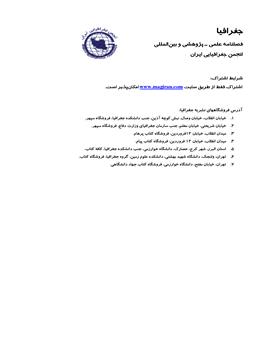Analizing quality of life compelitivens of Tehran in the Global area
Subject Areas :
1 -
2 -
3 -
Keywords: Frontage Sustainable Development Strategies Metropolis Tehran,
Abstract :
Tehran's territory is about 23 cities, 237 villages and hundreds of activities, covering a total of about 2 million people, which, along with national conditions, continues to attract immigrants, population growth and sustainability. Spread of official and informal settlements if we ignore the harassment of the northern part of Tehran, the southern zone is the focus of the poor and dense lives that seems to be the mechanism of civil disarmament of urban and regional development programs, Acceptance of this type of residence has made. In this article, referring to the studies and the secondary data collected in the field of social and cultural issues of the Tehran metropolitan area (especially the social and cultural impact assessment of the comprehensive plan of privacy) and SWOT analysis of about 30 experts in this area, summing up Challenges and socio-cultural issues of Tehran metropolitan area, the strategies of macroeconomic stability and sustainable development are based on the assessment of the socio-cultural impact of privacy in Tehran.
1. علی¬اکبری، اسماعیل، امینی، مهدی (1389)، کيفيت زندگي شهري در ايران (1365-1385). نشریه رفاه اجتماعی، 10(36). 148-121؛
2. موذنی، احمد؛ علیزاده اقدم، محمدباقر (1391)، بررسی کیفیت زندگی شهری: مدلی برای سنجش و رتبه¬بندی استانهای ایران با استفاده از تحلیل خوشه¬ای، مجله جامعه¬شناسی ایران.13(3).149-174؛
3. ساسانپور، فرزانه؛ حاتمی، افشار (1396)، تحلیل فضایی رقابتپذیری آموزشی استانهای کشور. فصلنامه علمی-پژوهشی اقتصاد و مدیریت شهری. ۵ (۱۹) :۴۵-۶۱؛
4. شاه¬آبادی، ابوالفضل؛ صادقی، حامد (1390)، ارزیابی وضعیت رقابت¬پذیری کشورهای عضو اوپک: با تاکید بر مولفه¬های نوآوری محور، رشد فناوری، 8 (29)، 15-3؛
5. شریف¬زادگان، محمدحسین؛ ندایی طوسی، سحر (1394)، چهارچوب توسعه فضایی رقابت¬پذیری منطقه ای در ایران، مورد پژوهی: استان های 30گانه، نشریه هنرهای زیبا-معماری و شهرسازی، 2 (3)، 20-5؛
6. شیرخانی، محمدعلی؛ خلف¬رضایی، محمود (1394)، سرمایه اجتماعی و رقابت¬پذیری در نظام بین¬الملل، فصلنامه سیاست-مجله دانشکده حقوق و علوم سیاسی، 45(3)، 740-721؛
7. ضرابی، اصغر؛ دیوسالار، اسداله؛ کنعانی، محمدرضا(1391)، تحلیل فضایی سکونتگاه¬های شهری براساس توان¬های محیطی (مطالعه موردی: استان مازندران)، دوفصلنامه مدرس علوم انسانی، برنامه¬ریزی و آمایش فضا، 16: (2)، 100-77؛
8. Alberti, F. G., & Giusti, J. D. (2012), Cultural heritage, tourism and regional competitiveness: The Motor Valley cluster. City, Culture and Society, 3(4), 261–273. https://doi.org/10.1016/j.ccs.2012.11.003;
9. Charles, V., & Zegarra, L. F. (2014), Measuring regional competitiveness through Data Envelopment Analysis: A Peruvian case. Expert Systems with Applications, 41(11), 5371–5381. https://doi.org/10.1016/j.eswa.2014.03.003;
10. Cibinskiene, A., Snieskiene, G., & Rqhodlþlrj, K. U. ’. (2015), ScienceDirect Evaluation of city tourism competitiveness. Procedia - Social and Behavioral Sciences, 213, 105–110. https://doi.org/10.1016/j.sbspro.2015.11.411;
11. Gabor, M. R., Conţiu, L. C., & Oltean, F. D. (2012), A Comparative Analysis Regarding European Tourism Competitiveness: Emerging Versus Developed Markets. Procedia Economics and Finance, 3(12), 361–366. https://doi.org/10.1016/S2212-5671(12)00165-7;
12. Jacek, Ż., & Gali, B. (2018), Advanced Concepts, Methodologies and Technologies for Transportation and Logistics (Vol. 572). https://doi.org/10.1007/978-3-319-57105-8;
13. Krskova, H., Krskova, H., Baumann, C., & Baumann, C. (2017), School discipline, investment, competitiveness and mediating educational performance. International Journal of Educational Management, 31(3), 293–319;
14. Kubickova, M., Croes, R., & Rivera, M. (2017), Human agency shaping tourism competitiveness and quality of life in developing economies. Tourism Management Perspectives, 22, 120–131. https://doi.org/10.1016/j.tmp.2017.03.002;
15. Lengyel, I. (2016), Competitiveness of Metropolitan Regions in Visegrad Counties. Procedia - Social and Behavioral Sciences, 223, 357–362. https://doi.org/10.1016/j.sbspro.2016.05.241;
16. Mendola, D., & Volo, S. (2017), Building composite indicators in tourism studies: Measurements and applications in tourism destination competitiveness. Tourism Management, 59, 541–553. https://doi.org/10.1016/j.tourman.2016.08.011;
17. Mira, M. R., Moura, A., & Breda, Z. (2016), Destination competitiveness and competitiveness indicators: Illustration of the Portuguese reality. Tékhne, 14(2), 90–103. https://doi.org/10.1016/j.tekhne.2016.06.002;
18. Parakhina, V., Godina, O., Boris, O., & Ushvitsky, L. (2017), Strategic management in universities as a factor of their global competitiveness. International Journal of Educational Management, 31(1), 62–75. https://doi.org/10.1108/IJEM-03-2016-0053;
19. Park, S. C. (2012), Competitiveness of East Asian science cities: Discourse on their status as global or local innovative clusters. AI and Society, 27(4), 451–464. https://doi.org/10.1007/s00146-011-0367-x;
20. Peng, L., & Zhanxin, M. (2011), The Evaluation of City Competitiveness in Shandong Province. Energy Procedia, 5, 472–476. https://doi.org/10.1016/j.egypro.2011.03.082;
21. Rogers, M., Bruen, M., & Maystre, L.-Y. (2010). Electre and decision support. https://doi.org/10.1007/978-1-4757-5057-7;
22. Schwab, K. (2017), The Global Competitiveness Report. World Economic Forum;
23. Sharma, S., Gray, D. K., Read, J. S., O’Reilly, C. M., Schneider, P., Qudrat, A., … Woo, K. H. (2015), A global database of lake surface temperatures collected by in situ and satellite methods from 1985–2009. Scientific Data, 2, 150008. https://doi.org/10.1038/sdata.2015.8;
24. Singhal, S., McGreal, S., & Berry, J. (2013), An evaluative model for city competitiveness: Application to UK cities. Land Use Policy, 30(1), 214–222. https://doi.org/10.1016/j.landusepol.2012.03.018;
25. Stanickova, M. (2015), Classifying the EU Competitiveness Factors Using Multivariate Statistical Methods. Procedia Economics and Finance, 23(October 2014), 313–320. https://doi.org/10.1016/S2212-5671(15)00508-0;
26. Verrill, S., & Johnson, R. a. (2007), Confidence Bounds and Hypothesis Tests for Normal Distribution Coefficients of Variation. Communications in Statistics - Theory and Methods, 36(12), 2187–2206. https://doi.org/10.1080/03610920701215126;
27. WEF. (2014), The Competitiveness of Cities.


